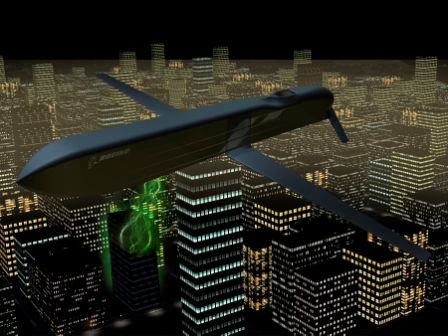Boeing missile zaps electronic devices in first test flight
October 29, 2012

(Credit: Boeing)
A recent weapons flight test in the Utah desert may change future warfare after the missile successfully defeated electronic targets with little to no collateral damage.
Boeing and the U.S. Air Force Research Laboratory (AFRL) Directed Energy Directorate at Kirtland Air Force Base, N.M., successfully tested the Counter-electronics High-powered Microwave Advanced Missile Project (CHAMP) during a flight over the Utah Test and Training Range.
CHAMP, which renders electronic targets useless, is a “non-kinetic alternative to traditional explosive weapons that use the energy of motion to defeat a target,” according to Boeing (not clear what that means).
During the test, the CHAMP missile navigated a pre-programmed flight plan and emitted bursts of high-powered energy, effectively knocking out the target’s data and electronic subsystems.
“This technology marks a new era in modern-day warfare,” said Keith Coleman, CHAMP program manager for Boeing Phantom Works. “In the near future, this technology may be used to render an enemy’s electronic and data systems useless even before the first troops or aircraft arrive.”
Most press reports have incorrectly described this as an electromagnetic pulse (EMP) weapon. High power microwave (HPM) is a different technology that uses a microwave beam that can be focused tightly to hit designated short-range targets, as explained in the 2004 High Altitude Electromagnetic Pulse (HEMP) and High Power Microwave (HPM) Devices: Threat Assessments report to Congress.
Boeing refused a request from KurzweilAI for further information “due to the sensitive nature of the program,” a spokesperson said.